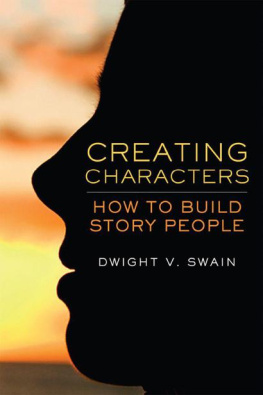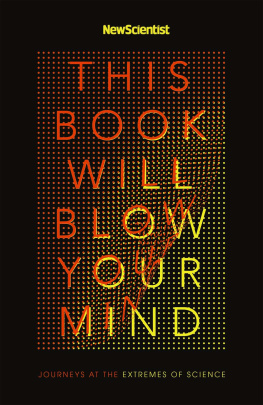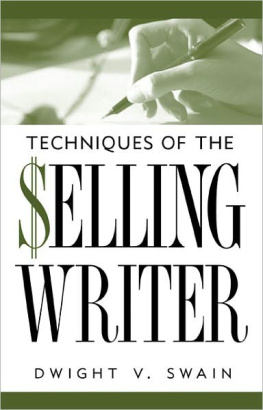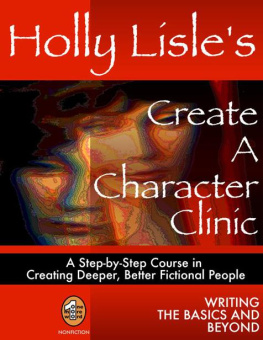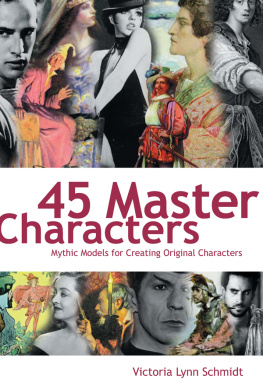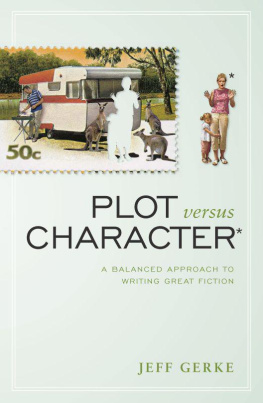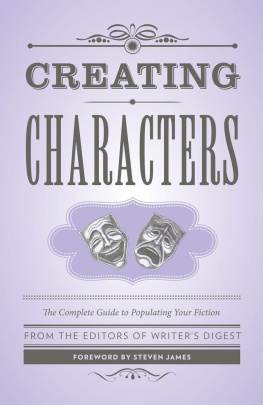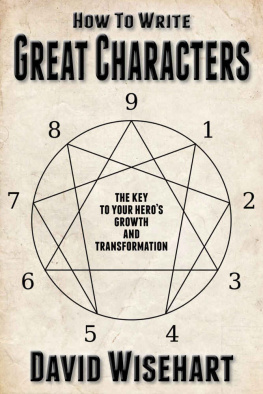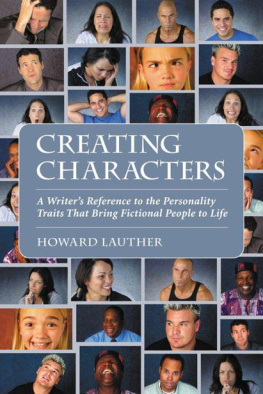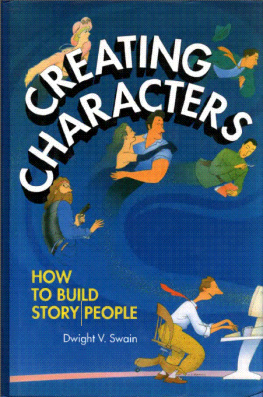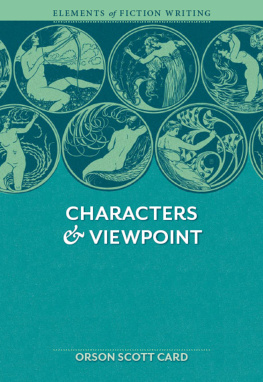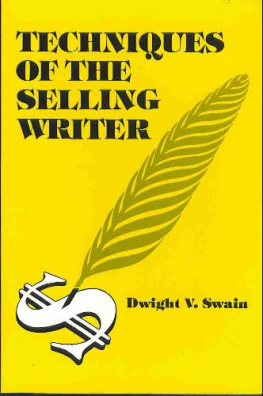CREATING CHARACTERS: How to Build Story People
Dwight V. Swain
University of Oklahoma Press

2800 Venture Drive
Norman, Oklahoma 73069
www.oupress.com
Originally published by Writers Digets Books, an imprint of F&W Publications, Inc., Cincinnati, Ohio, copyright 1991 by Dwight V. Swain. Oklahoma Edition copyright 2008 by the University of Oklahoma Press, Norman, Publishing Division of the University. Manufactured in the U.S.A.
All rights reserved. No part of this publication may be reproduced, stored in a retrieval system, or transmitted, in any form or by any means, electronic, mechanical, photocopying, recording, or otherwiseexcept as permitted under Section 107 or 108 of the United States Copyright Actwithout the prior permission of the University of Oklahoma Press.
For information about permission to reproduce selections from this book, write to Permissions, University of Oklahoma Press, 2800 Venture Drive, Norman, Oklahoma 73069 or email .
ISBN 978-0-8061-3918-0 (paperback : alk. paper)
ISBN 978-0-8061-8384-8 (ebook : mobipocket)
ISBN 978-0-8061-8385-5 (ebook : epub)
This eBook was converted from the original source file by a third-party vendor. Readers who notice any formatting, textual, or readability issues are encouraged to contact the publisher at .
For Phyllis A. Whitney...
fine writer and good friend
CONTENTS
PREFACE
Fiction grows from story people.
This book is designed to help you bring such people into being. From it youll learn barn-brush characterization. Subtlety youll have to master on your own.
(Remember what Somerset Maugham said about that? I was surprised when a friend of mine told me he was going over a story he had just finished to put more subtlety into it; I didnt think it my business to suggest that you couldnt be subtle by taking thought. Subtlety is a quality of the mind, and if you have it you show it because you cant help it.)
Why will you learn barn-brush characterization? Because I learned my basics in the action pulps, thats why. Anything else is after the fact.
Beyond that, barn-brush handling is what you need to start. It focuses you on the basics and its easy for both reader and writer to understand.
Not that youll stop there, please note. Indeed, you cant stop, because with every story you write your mind will automatically reach out, groping for better, more effective ways to draw your people. As you find them, make them part of your private kit of literary toolsyour skill will increase and your work will improve in keeping with your taste and the direction of your aspirations.
So, here well start with the broad strokes of a barn brush, and dont be disdainful of the techniques this approach offers. It works, believe me. Indeed, if youre of an analytic turn of mind, youll soon discover that, each in his or her own way, the men and women who created the worlds classics used the same devices presented here.
How should you use this book? A good way to start, it seems to me, is a quick scan. That will give you an idea of your present skill, and where youre strong and weak. Then you can decide for yourself whats old and whats newto you, that isand where you need to dig in and bear down.
I do not suggest that you work by the numbers, as it were. Thats a sure way to make writing a drudgery, and writings hard enough without that. Rather, fly by the seat of your pants, setting down characters as they surface in your story. Then, go back and troubleshoot the product, reworking to improve any of your people whom you feel might benefit.
The key word above, please note, is improve. Anyone can create a character. What I offer here are merely some time-tried devices by which to make such pseudo-beings better. Sometimes. Because even the best of devices wont always work. At its heart, ever and always, writing remainsto a greater degree than we like to admita trial and error process. So as you work and study to acquire skill, never forget to pray a little too, for in the clinch we all need to have Lady Luck riding high upon our shoulders.
Its the custom in a book like this for the author to acknowledge the help hes received from others along the way.
For me, the list would be far too long to include herethe more so, since memory being as fallible as it is, some not included would be sure to have hurt feelings. Let me say only, therefore, that Ive learned about character and characterization from every book Ive ever read, every student Ive ever taught, every editor whos bought or rejected my work.
One name just cant be left out, however: that of my wife Joye R. Swain, whose keen insights and discerning eyeand whose too-often frayed and raveled patiencehelped to give this book its cutting edge.
Words cant express my gratitude to her.
1
THE CORE OF CHARACTER
Whats the one key element any major character must have?
The ability to care.
The core of character, experience tells me, lies in each individual story persons ability to care about something; to feel, implicitly or explicitly, that something is important.
Be aware, please, that it doesnt matter whether this something is major or minor, cataclysmic or trivial, or at any level in between. It may be money thats important to him, or family, or world peace, or ecology, or a vacation, or country living. What matters is that he cares about it.
Additionally, it really is inconsequential whether Individual is aware that he feels the way he does. The crucial issue is that the feeling exists to the point that its strong enough to move him.
How does this build into a story?
Here is a manan orderly man, well say arbitrarily. Hes neat by habitso much so that hes hardly conscious of it, doesnt even think about it. His shirts are folded neatly in their drawer, his ties hung on a proper rack, the bills in his billfold arranged in order so that the fifties are in the back, the ones in front.
Now he marries. His wife, it proves, is content to let dirty clothes pile up in the corner of the bedroom. The living room floor is ankle deep in junk mail and old newspapers. Dishes go unwashed for two days, three days, a week.
Order is important to Husband, he discoversfar more important than he realized. Or maybe he doesnt discoverthat is become aware ofhis compulsion to orderliness, save in terms of scowls and sullenness and flaring temper. He forgets all the reasons he married Wifeher charm, her intelligence, her spontaneity, her sense of humor, her laid-back, relaxed way of looking at the world. All he can think of now is her insouciance where order is concerned.
Do you see whats happening? We started with a stick figure labeled man. Add something thats important to him, something that he cares about consciously or otherwisethe focus on orderand he becomes a person. A character has begun to take form.
Is this all there is to it? Dont be ridiculous. Character creation is a deep and involved subject, as witness to that youre holding a whole book focused on it. But no matter how far or fast you go, the core is still an individual characters capacity for caring, his ingrained ability to feel that something is important. Once you understand that, youve jumped the highest hurdle in the process of creation.
You need to remember, however, that not all characters have the same potential for building into a story. The freaky, the repellent, the boring are unlikely candidates. Indeed, quite possibly theyll alienate most readers. Your best bets are sympathetic characterscharacters with whom the reader is able to share and empathize, at least in imagination. And if we use evil characters, they must intrigue us, even though we cant accept their goals.

